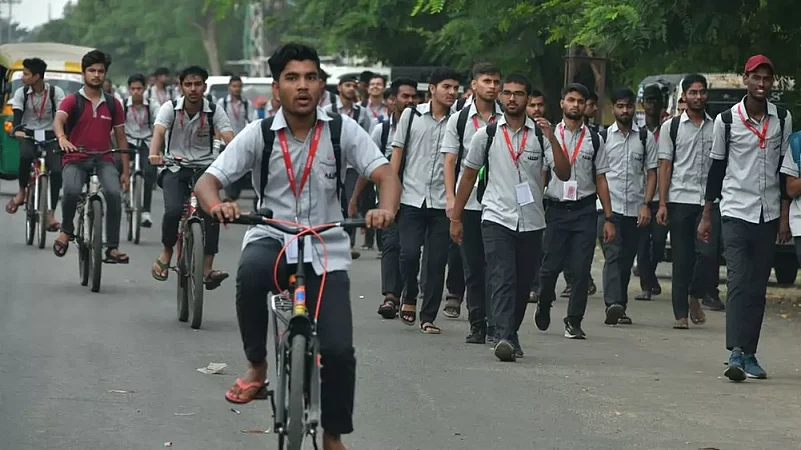“I am not a psychologist but I believe guilt drives young students to end their lives. Self-loathe and the feeling of uselessness make them feel guilty and push them to take the extreme step. This guilt can come from academic pressure, parental pressure and several such factors. But the police will not tell you all this. They will say students die because of the cancerous problem of exploitation.”
-- Pramod Maheshwari, Indian educator and entrepreneur, based in Kota
In the 1990s, after graduating from Indian Institute of Technology (IIT) Delhi, Maheshwari, like many others, dreamed of going to the US and making a living there. But when he decided to stay back and live with his parents in his hometown Kota, life took a different turn. Since there was nothing much to do, he started teaching Physics to students in Kota so that they didn’t have to leave the city to realise their IIT dreams.
When Maheshwari, along with another educationist, Vinod Kumar Bansal, started teaching students, their aim was simple—helping students. Soon other players joined the fray, but money was not a dominant factor then. However, two decades later, commercialism has taken over, and the primary aim of coaching centres that have mushroomed across Kota over the years seems to be minting money. The unimaginable pressure put on students so that they can crack medical and engineering entrance exams takes and toll on their mental and physical health. Over the years, many students have died by suicide in Kota—18 deaths in 2019, 20 in 2018, seven in 2017, 17 in 2016, and 18 in 2015. In 2023, there have already been 24 deaths by suicide.
The focus is back on the ‘educational environment’ in the ‘coaching hub’ of India. Students as young as 14-16 years of age enroll themselves in these coaching centres. Away from the comfort of their homes and pushed into a life centred around gruelling schedules, these students undergo a tremendous amount of stress. Eventually, a few succumb to the pressure.
“It is a crime to admit students who are this young,” believes Maheshwari, who recalls that back in their time, there would be a necessary filtering of students. A proper entrance test was conducted to assess the ability of the candidates who had the potential to make it to the IITs. He feels that this was the sole reason why Kota had a higher success rate back then. Calls were made to students who they thought would not perform well in this stream down the line.
Although there is no substantial data that gives us the exact success rate of Kota in the current times, however, faculty members here have admitted that it has reduced. “There was a time when 60-70 per cent of students would make it to the top. I don’t think the same is the case anymore because a business model has taken over,” says Mahewhari, who says that he has no fear of revealing the real Kota story.
“I am disappointed to say that I personally believe Kota is now a commercial place. Nobody will tell you this. People will turn against me if I speak these words in Kota, because of all the coaching centres and running a business,” he says.
In the 2000s, even when there was a boom, the stress on commercialisation was much less. “But when the demand went up and the sector expanded, as business interest took over,” he says, adding that the quality of education started deteriorating post-2011.
The primary reason behind this, Maheshwari believes, is the discrimination that creeps in because of the scholarships that are granted. Several institutions here offer scholarships only on merit, and the monetary gap that gets created is filled by those with deep pockets but who don’t have an academic edge because of their socioeconomic backgrounds. Thus, a merit-based scholarship does little to help those who are in need of funds.
“Today, most of the institutions are perhaps running a talent-search examination, which is conducted all across the country. Then you pick a few smart students and give them 100 per cent scholarship while the rest get scholarships which seem like sales promotion schemes,” says Maheshwari.
He also believes that a major part of the stress comes from the long duration of coaching classes and less time given for self-study. The six-hour-long classes, followed by four-hour-long doubt classes make students believe that there is a system in place that will help them solve all their doubts. “This thought process is fundamentally wrong. Reduce the hours of these classes and let them study on their own. Time to one's self is important to excel in whatever one dies because when they cannot excel you will put the entire blame on them, rather than taking the responsibility on self,” he says.
In the internal tests, a few students perform well and the rest don’t. “But nobody is counselling them. They are told that they will be able to do it. The motivational talks do more harm. They take the kids away from reality and when they must come face to face with reality, accepting it becomes a challenge. That's the problem. I also conduct a lot of motivational sessions, and I also sometimes feel it’s wrong,” admits Maheshwari.
He admits that Kota has the best infrastructure, a well-built ecosystem, and the best of the teachers, and hopes it will all be fine if the focus is shifted back on quality and not quantity.


























